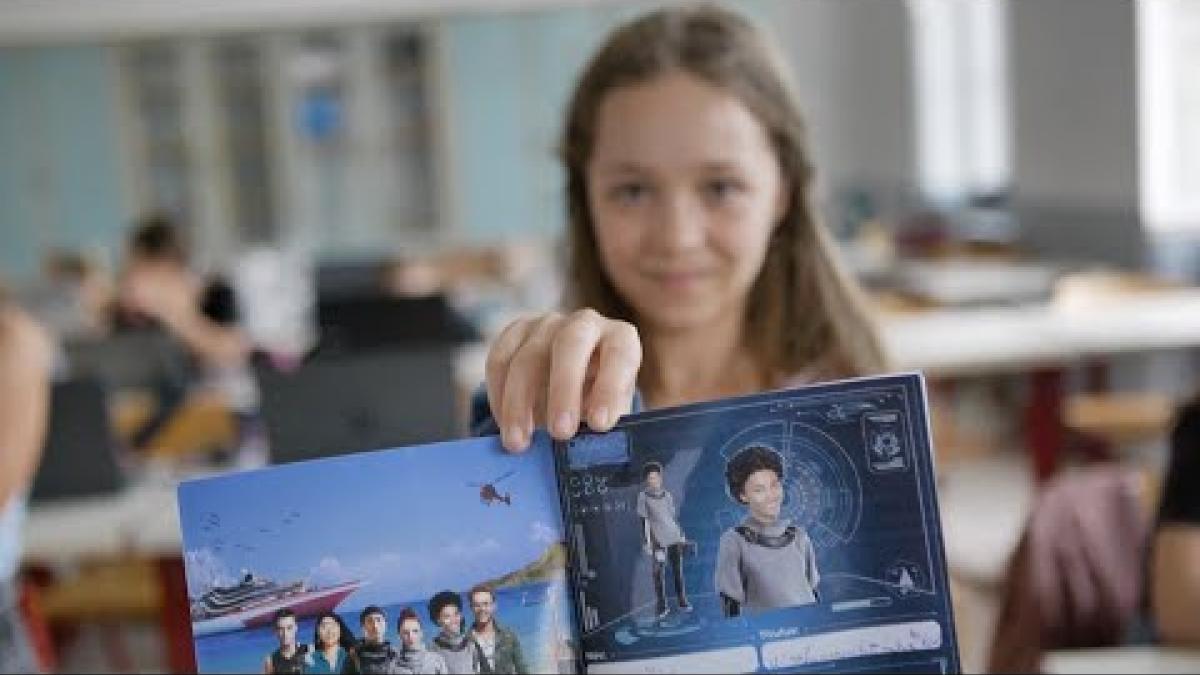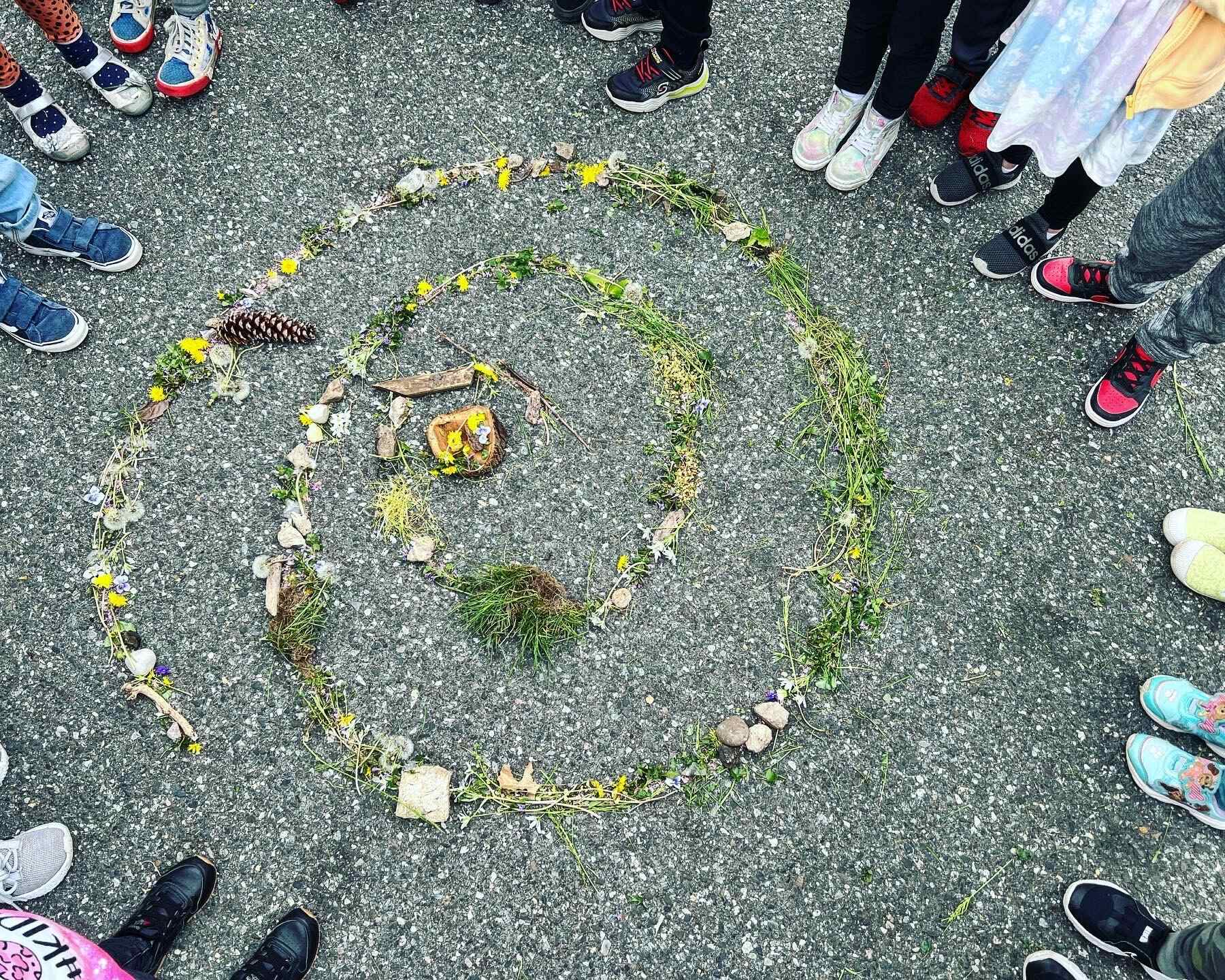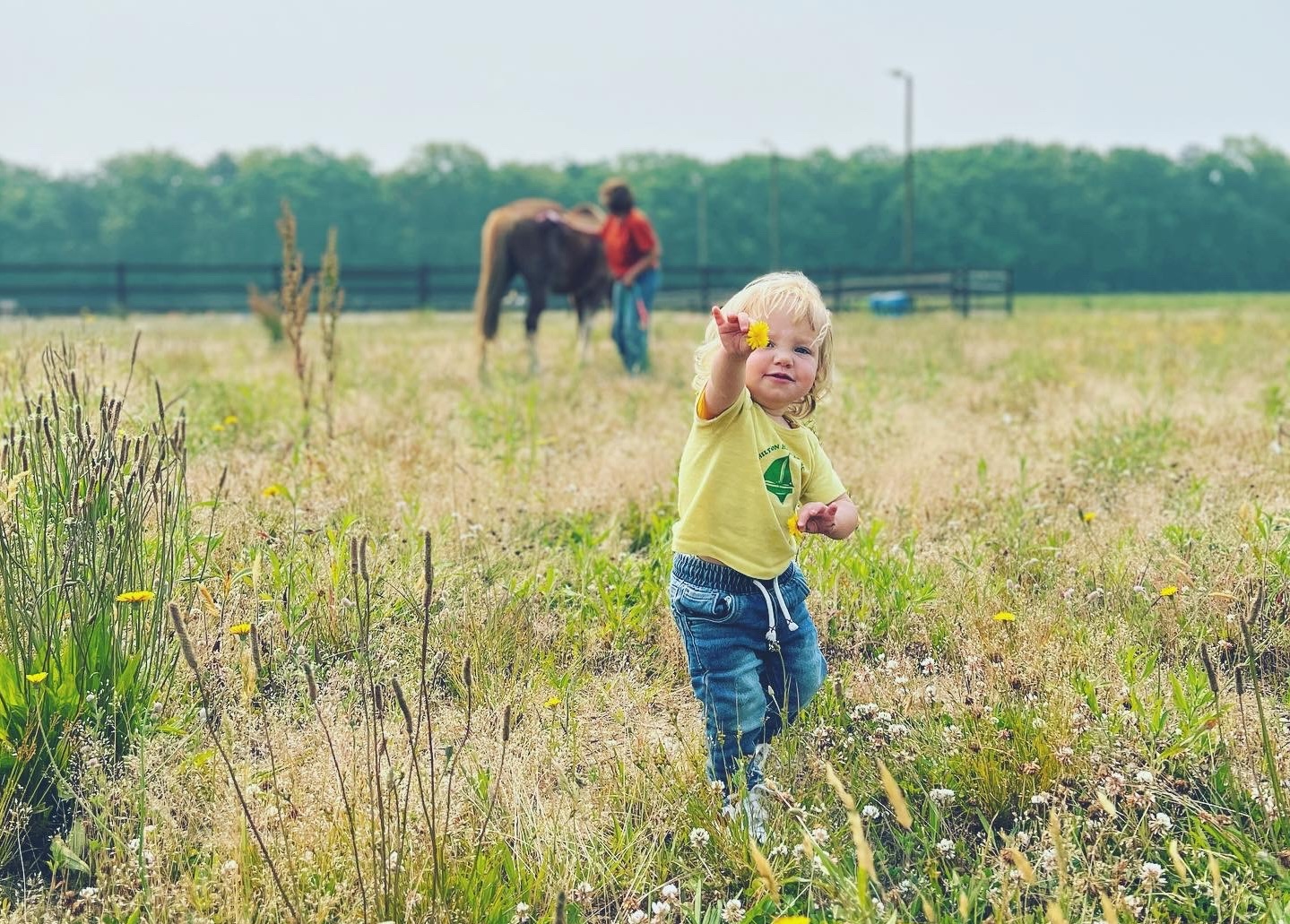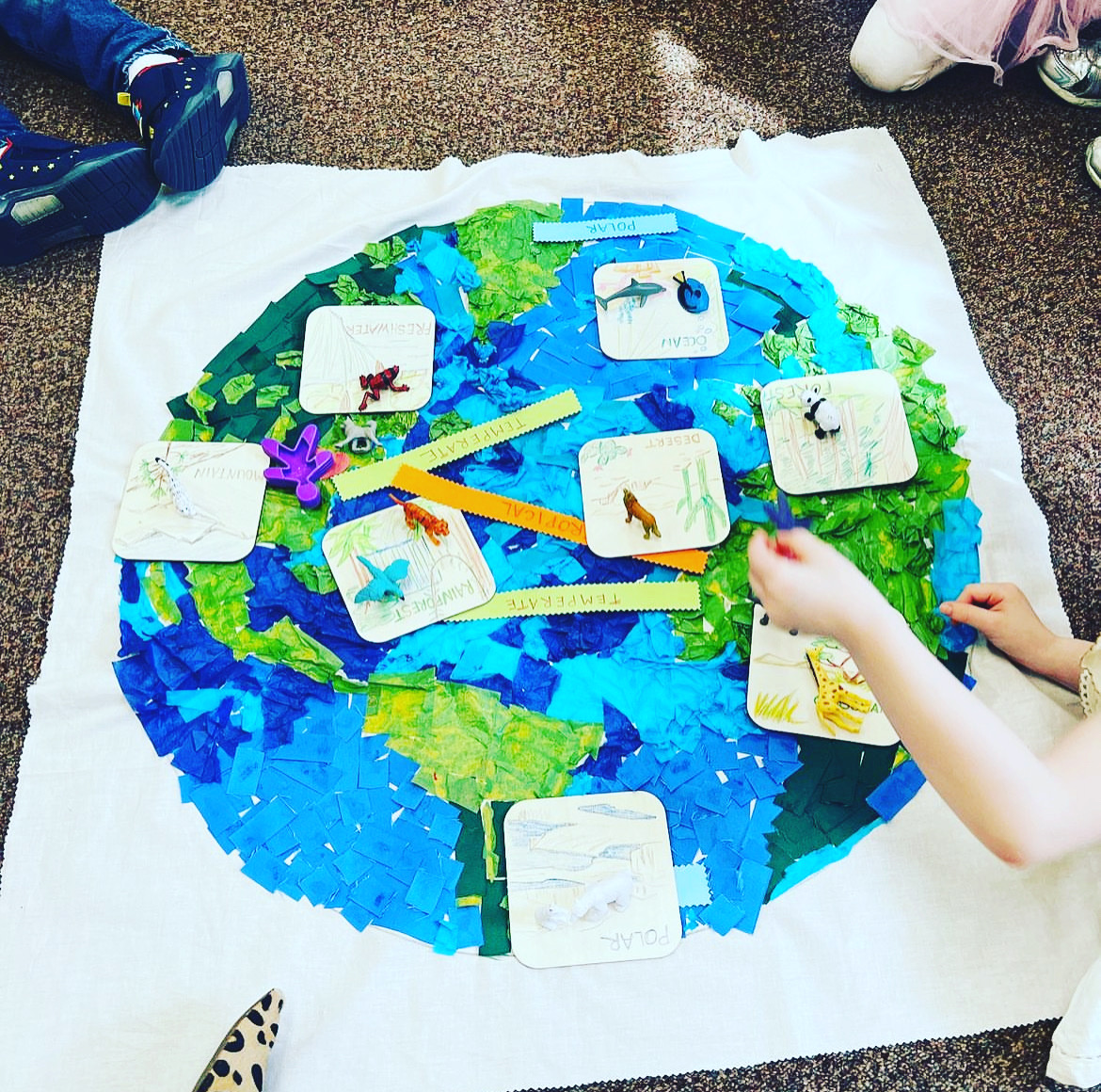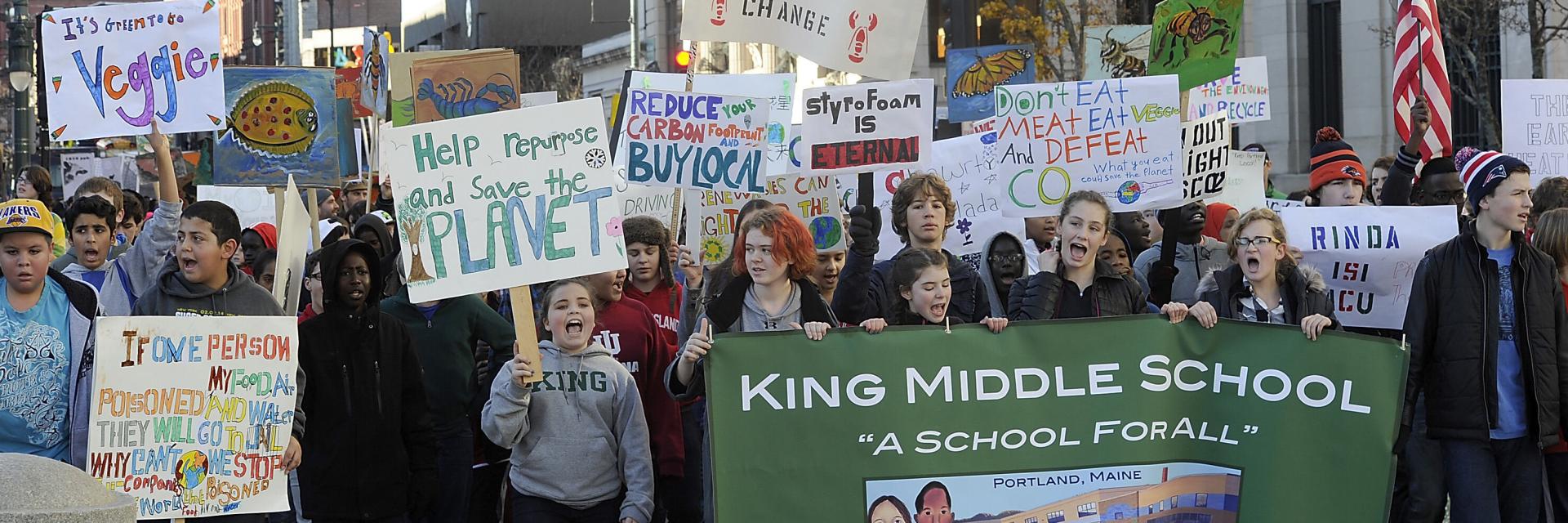
400 students from King Middle School marched from the school down Congress to Portland City Hall to promote climate change awareness.
Credit: Gordon Chibroski/Portland Portland Press Herald via Getty ImagesEnvironmental Education
Empower children with an education that fosters environmental stewardship, climate resilience, and an understanding of ecological principles.
Educating children is a key agent in addressing the climate crisis. Environmental education empowers our youngest citizens with the agency to make sustainable and regenerative lifestyle choices to preserve and protect life on our planet. Globally, 83 percent of young people feel that “people have failed to care for the planet,” yet cultivating care for our environment has historically been absent from mainstream educational settings. Today, teachers can find a myriad of online directories and portals filled with environmental and climate change content. Still, the North American Association for Environmental Education (NAAEE) found that 65% of teachers in the United States do not feel prepared to teach climate change, and 26 percent do not see how it aligns with all subjects. While there is a bounty of learning resources out there for the individual, the materials for educators must further consider the appropriate age and subject requirements necessary to teach children. Teachers, educators, and school administrators need easy access to reliable and reviewed curricula, frameworks, materials, and professional development that support integrating environmental literacy and climate change education across all disciplines in pK-12 classrooms.
Action Items
Individuals
Learn why environmental education needs to be included in the mainstream educational infrastructure. Environmental education equips future generations with the skills, resilience, and information they need to thrive in a changing world. It includes climate change education, ecological literacy, environmental awareness, nature-based learning, and outdoor classroom experiences.
- The benefits of integrating environmental education in classrooms extend beyond practical knowledge. Children experience personal growth, practice civic engagement, improve critical thinking, and enjoy academic achievement.
- Social emotional learning (SEL) is inherent to environmental education. SEL is a widely required component of educational materials to strengthen the mental health and well-being of children. It’s especially relevant to bring into climate education, as reported by UNESCO: “In the United States, with some exceptions, state standards and curriculum frameworks generally do not have a holistic approach to climate change, but instead focus on cognitive learning.”
- Environmental Education addresses equity and inclusion. Teachers and schools that model sustainable behaviors through routines and practices and include children in these daily activities allow all children to “see themselves reflected in their broader environment, one in which diversity is honored, and all individuals are respected.” For example, children can participate in food waste sorting or energy conservation in their school environment when that might not be an opportunity in their home. Bringing such learning experiences together fosters inclusion and strengthens relationships and understanding across communities.
- Children (and adults) develop a stronger connection to nature through environmental education—in both indoor and outdoor settings. Inside, caring for plants or animals increases respect and empathy, and playing and learning with objects found in nature provides sensory experiences and provokes children into thought, action, and formulating their own ideas. Children who spend more time outdoors greatly benefit, evidenced in decreased anxiety, depression, and anger, and improved attention span and mental and physical health.
- Environmental Education can cross intergenerational boundaries and dissolve the challenge of generational amnesia. Specific to the environment, generational amnesia is when our baseline for decline in the natural world shifts with each generation—the sounds and smells of the forest of your youth will not be the sounds and smells of the forest that your children will remember from their youth. It is a silent and collective forgetting of our natural world.
- Environmental Education fosters active citizenship among children of all ages, and when children grow up with the tools and resources, they can institute changes, advance policies, and be heard in courtrooms on local, national, and international levels.
- Developmentally appropriate environmental education is a gateway to engaging and educating families and communities on the health benefits of nature and the effects of human impact on the planet. However, conventional climate literature is often a large deterrent for communities because it can be hard to digest for those without a scientific background.
Understand the challenges faced by schools and teachers. While math and literacy remain prioritized in primary through high school classrooms across the world, the current educational systems are failing to prepare young people to handle the climate crisis. In 1975, UNESCO’s Belgrade Charter established that environmental education would be necessary to avoid short-sighted responses to environmental crises. UNESCO surveyed 100 countries in 2021, and 47 percent of national curricula make no reference to climate change or similar initiatives, and less than 25 percent of teachers felt able to address climate change, which is likely why schools and teachers across the world have largely avoided or neglected environmental education in their classrooms.
- The majority of schools do not require comprehensive instruction on climate or environment outside of high school science classes.
- Teachers and educators lack the necessary frameworks and vetted materials to bring environmental education into their classrooms. Resources abound to inform the public of the challenges and solutions; however, teachers and formal educators are directed to sift through resources for their classrooms and make sense of how they can interpret and integrate their learning into classroom lessons, activities, and tools. This is time-consuming, confusing, and adds to their workload.
- Teachers require programs, plans, curricula, and frameworks that can integrate with existing materials. Schools and decision-makers are challenged by the education requirements that come with introducing any content into a classroom, including developmentally appropriate practices, aligning with standards, and the need to provide professional development and training.
Get involved. Families, parents, and community members can take an active role in educating children.
- Join your local PTA or PTO (parent-teacher association) to be a voice for environmental education and action. Or set up your own parent-teacher organization or be the person who brings parents, schools, and teachers together for a common cause, like this parent.
- Learn about school governance. Run for a board seat or an office to affect policies and requirements for environmental education in schools.
- Share your concerns or ideas about environmental education with a school administrator, principal, or curriculum director. Parents and families can be changemakers.
- Volunteer your services. Talk to your children’s teachers to see what they welcome. You could help maintain the school garden, host a nature walk, clean up a wildlife area, or teach a skill to a classroom.
Groups
Teachers, Educators & Administrators
Advocate for environmental education in your classrooms. Include interdisciplinary approaches to environmental education and climate change education.
- Reach out to schools and districts that are setting the example with new climate-aligned standards or green initiatives inside or outside of the classroom to see how you can bring this to your school or community, such as the Vancouver School Board’s Indigenous Education program.
- Transform a challenge for students into a solution for a community, like one teacher did with his classroom.
Seek out professional development for teachers and staff. Sign up for virtual (or in-person) workshops, webinars, and conferences to learn more about implementing environmental education in your classroom, such as those offered by SubjectToClimate, Educator Advocacy Tool Kit from This Is Planet Ed, or Green School’s Educator Program. Ask about curricula and programs that offer manageable and sustainable frameworks for integration and enrichment.
Join environmental education networks. There are many networks that specifically support schools in making sustainable choices and introducing environmental programming.
- TAG (Take Action Global) supports teachers in helping students be curious, learn about the environment, and make a difference in our world through projects, resources, and other innovative education practices.
- Eco Schools is one of the largest global networks and works with FEE (Foundation for Environmental Education) chapters in 73 countries.
- SEED, based out of the UK, offers programs tailored to teachers, students, and institutions.
- Teach For All’s Climate Action and Leadership is an education network that shares climate success stories from around the world to inspire collective action.
- GEEP (Global Environmental Education Partnership) unites sustainable schools worldwide and strengthens environmental education on a global scale.
Educate yourself. Attend an environmental education conference, like the annual NAAEE conference. Or attend a workshop, sign up for an environmentally informative newsletter, or visit a green fair hosted in your town.
Schools & Districts
Prioritize multidisciplinary environmental education. Provide resources and professional development for teachers to bring environmental education into their classrooms through manageable and sustainable practices. Another option is to get involved with CAPS (Climate Action Pathways for Schools), which provides students with skills and experiences to enter the green workforce.
Apply for Grant Funding. Government institutions (like the EPA) and private foundations (like Rockfall in Connecticut or The Solutions Project in California) offer grants to support environmental resources and sustainability projects on local, national, and international levels. Use a site like Instrumentl to search for funding by location.
Implement school and district sustainability practices on site. Schools can model climate solutions directly, transitioning to clean energy onsite through solar panel installation or capturing rainwater with a rain barrel to water the garden. Start a school-wide composting program to reduce food waste at lunch or run a recycling drive to reduce hard-to-recycle plastic waste such as markers. Post a “No Idling” sign to reduce emissions. Plant a pollinator patch. Research education-related discounts and rebates to lower costs and help projects stay within budget.
Share successes. When environmental education becomes mainstream in your school, share stories and successes to pave the way for other schools and learning centers. Bring up what your school is doing in conversation with peers and colleagues. Or, like the Garrison Union Free School District’s Youth Climate Summit, hold an event to celebrate and educate your community and inspire others.
Communities & Families
Organize a green job day. Many schools host “Bring your Parent to School” days to show children what they can be when they grow up. Organize parents and community members with eco-careers in fields such as conservation, environmental justice and climate solutions to come into schools and share what they do. Read “The Parents’ Guide to Green Careers Week” for inspiration.
Fundraise for environmental programs. There are sustainable and regenerative fundraising options, thanks to organizations like Terra Cycle’s Recycle at School or Forest Nation’s school fundraising programs.
Universities
Provide professional development for preservice teachers. Include guest speakers or facilitate workshops that introduce education students to environmental curricula, frameworks, and content for their classrooms.
Create degrees and disciplines to empower a new generation of teachers with the language and skills to teach environmental education in the classroom. The University of Cincinnati has the first online early childhood education degree focused on nature-based early learning.
Create or fund research opportunities to show the effects of teaching environmental education in schools and classrooms. The more data available on climate resiliency efforts, emissions reduction, nature-based learning, place-based education, and SEL in education, the more resources schools and organizations will have available.
Companies
Provide discounted services, products, and resources for schools and teachers. For those companies that offer sustainable options, there is an opportunity to help schools lower expenses and for companies to expand consumer reach—either at local or national levels. Supbod offers discounted compost bins and kits as a part of its school program, while Wisdom Supply has shifted the impact of school supplies to be wholly sustainable.
Sponsor a school. Schools and centers often aspire to offer environmental education programs or projects that extend beyond their budget. Allocate funds or raise a set dollar amount through your consumer base to donate to a school in your neighborhood or one seeking funding for a project.
Provide resources at low to no cost to schools. The Institute for the Built Environment has a toolkit for schools on a budget. Participate in school events or fairs to share information or send representatives with materials into classrooms. Educate and empower children by showing them what green jobs and careers are available, like the water stewards of RanMarine.
Key Players
Programs, Curricula & Frameworks
Earth Friends (US: pK-3) offers environmental education for early childhood.
Earth Warriors (UK; pK-12) offers climate change education for all ages.
EnviroEdu (AUS; pK-10)
Project Learning Tree (US; K-8) provides ecology and environmental curriculum.
SEI (US; K-12) offers a project-based sustainability curriculum.
Project Wet (US; K-12) provides water-focused educational materials and training.
Project Wild (US; K-12) provides fish & wildlife education materials and training.
OER Climate Project (US; 6-12) is a stand-alone elective or supplemental material designed for social studies or science classes.
EcoRise (US; K-12) standards-aligned lessons and teacher education courses.
Activities, Lessons & Learning Packs
Regeneration Learning Hub (US; K-12) has over 100 free cross-curriculum lessons catering to all levels from primary through to high school.
Subject to Climate (US; K-12) has free climate resources for all K-12 subjects.
Compass Education (Global; pk-12) is bringing sustainability and systems thinking into the classroom with tool kits, lesson plans, and activities.
Earth Rangers (US; K-12) has classroom activities, eco-hub plans, and professional development.
Green Learning (CA; 1-12) offers education programs to empower children to learn about energy, climate change, and a green economy.
ESA (European Space Agency) (Europe; 3-12) has classroom resources to engage students in learning about Earth’s changing climate and how we monitor our planet from space.
Deutsche Welle DW (Germany; 7-12) offers nine multimedia environmental learning packs.
World Wildlife Federation UK (UK; 2-4) provides introductory climate change teacher Packs.
Education Organizations & Resources
NOAA’s Education Portal is a one-stop shop that connects learning and teaching resources about the ocean and atmosphere, as well as curricula, lesson plans, and real-time data to bring NOAA science into your classroom.
Climate Generation Resource Library offers K-12 and nonformal educators access to resources, professional development, inspiration, and community networking to teach climate change in all disciplines, grade levels, and educational settings.
National Geographic Education Resources provides immersive experiences, interactive lesson plans, maps, and other free resources to be curious and learn with National Geographic.
Gaia Scholastic is a consulting company that guides teachers, schools, and districts to integrate environmental education into the classroom through standards-driven, interdisciplinary curriculum and professional development for teachers.
CLEAN offers free teaching resources for K-12 on climate and energy.
NEEF K-12 Education provides environmental education activities that develop a deeper sense of environmental stewardship.
NAAEE eePRO offers activities, publications, media, and many more resources posted by professionals around the world designed to enrich classrooms.
ECCLPs (Environmental and Climate Change Literacy Projects is advancing PK-12 climate and environmental literacy, justice, and action.
Children & Nature Network provides global lessons on greening school grounds and outdoor learning.
Turning Green (K-12+) is a global student-led movement devoted to cultivating a healthy, just, resilient planet through education and advocacy around climate justice, environmental sustainability, and public health. They also run Project Green Challenge, an annual competition for 16+ students featuring 30 days of eco-themed challenges with prizes.
The Government of Canada (K-12) offers educators extensive resources as part of its website's climate action section.
The Canadian Network for Environmental Education and Communication (K-12) is Canada’s only national French-English bilingual charitable network for environmental learning.
Individuals
Frank Niepold is the climate education program manager at NOAA.
Rachel Arbor is an award-winning environmental education consultant.
Suzie Hicks has created an award-winning climate solutions TV series for children.
Janna Hockenjos is the founder of Earth Friends.
Lauren Madden is a professor of science and elementary education and is at the forefront of standards that provide a transdisciplinary approach to environmental education.
David Sobel is an author and pioneer in place-based nature education.
David Wilgenbus is the Director of the Office for Climate Education in Paris.
Learn
Watch
Found in the Forest Documentary (112 mins.)
Environmental Education & Civic Engagement by CivicEcologyLab (74 mins.)
A Better Approach to Environmental Education by Sean Cain / TEDx Talks (14 mins.)
Read
Miseducation: How Climate Change is Taught in America by Katie Worth / Columbia Global Reports
The Climate Optimist Handbook by Anne Therese Gennari / The Climate Optimist, LLC
Last Child in the Woods by Richard Louv / Algonquin Books
Strengthening EE In Your Country: A Discussion Guide by GEEP Leadership and Advisory Group / GEEP
Guidelines for Excellence Series by NAAEE / NAAEE
Green Teacher Magazine helps to enhance environmental literacy among educators.
The Climate Review is a student-led publication dedicated to the interdisciplinary challenges of climate change.
Listen
Talking with Green Teachers Podcast hosted by Green Teacher
Outdoor Classrooms hosted by Victoria Hackett
Share this page

